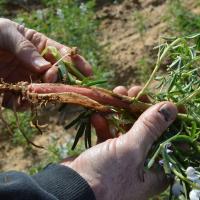How to assess pulse nodulation
The following procedure should be used in order to assess the degree of nodulation found on pulse plants;
- Assess crop nodulation 10 – 12 weeks after sowing
- Carefully dig 10 plants at random across the area to be assessed, keeping the soil intact around the root ball of the plant
- Very carefully wash dirt off plant roots in a bucket of water
- Rinse the root systems and observe the nodules found on the root system (observing the size, number and colour of the nodules)
- Score the root system, using the diagram below
Interpreting pulse nodulation assessment
Poor nodulation may be due to a number of agronomic factors which should be explored. The reasons why rhizobium does not thrive may be due to any number of reasons including:
- Poor environmental conditions (cold temperatures, moisture stress) during emergence and growth of the crop
- Soil pH may not suit the survival of the particular rhizobia for the crop
- Poor establishment of soil rhizobia by previous crops grown in the paddock
- Poor inoculation
- Fertiliser practices
- Root diseases like Rhizoctonia



